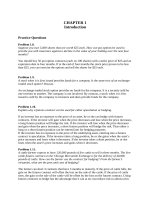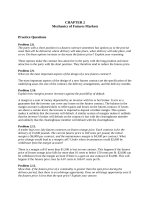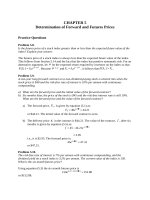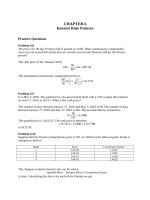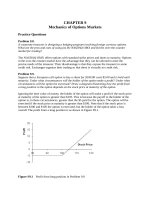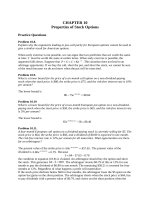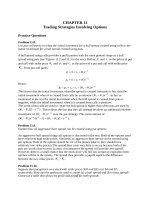Solutions fundamentals of futures and options markets 7e by hull chapter 01
Bạn đang xem bản rút gọn của tài liệu. Xem và tải ngay bản đầy đủ của tài liệu tại đây (112.96 KB, 9 trang )
CHAPTER 1
Introduction
Practice Questions
Problem 1.8.
Suppose you own 5,000 shares that are worth $25 each. How can put options be used to
provide you with insurance against a decline in the value of your holding over the next four
months?
You should buy 50 put option contracts (each on 100 shares) with a strike price of $25 and an
expiration date in four months. If at the end of four months the stock price proves to be less
than $25, you can exercise the options and sell the shares for $25 each.
Problem 1.9.
A stock when it is first issued provides funds for a company. Is the same true of an exchangetraded stock option? Discuss.
An exchange-traded stock option provides no funds for the company. It is a security sold by
one investor to another. The company is not involved. By contrast, a stock when it is first
issued is sold by the company to investors and does provide funds for the company.
Problem 1.10.
Explain why a futures contract can be used for either speculation or hedging.
If an investor has an exposure to the price of an asset, he or she can hedge with futures
contracts. If the investor will gain when the price decreases and lose when the price increases,
a long futures position will hedge the risk. If the investor will lose when the price decreases
and gain when the price increases, a short futures position will hedge the risk. Thus either a
long or a short futures position can be entered into for hedging purposes.
If the investor has no exposure to the price of the underlying asset, entering into a futures
contract is speculation. If the investor takes a long position, he or she gains when the asset’s
price increases and loses when it decreases. If the investor takes a short position, he or she
loses when the asset’s price increases and gains when it decreases.
Problem 1.11.
A cattle farmer expects to have 120,000 pounds of live cattle to sell in three months. The livecattle futures contract on the Chicago Mercantile Exchange is for the delivery of 40,000
pounds of cattle. How can the farmer use the contract for hedging? From the farmer’s
viewpoint, what are the pros and cons of hedging?
The farmer can short 3 contracts that have 3 months to maturity. If the price of cattle falls, the
gain on the futures contract will offset the loss on the sale of the cattle. If the price of cattle
rises, the gain on the sale of the cattle will be offset by the loss on the futures contract. Using
futures contracts to hedge has the advantage that it can at no cost reduce risk to almost zero.
Its disadvantage is that the farmer no longer gains from favorable movements in cattle prices.
Problem 1.12.
It is July 2010. A mining company has just discovered a small deposit of gold. It will take six
months to construct the mine. The gold will then be extracted on a more or less continuous
basis for one year. Futures contracts on gold are available on the New York Mercantile
Exchange. There are delivery months every two months from August 2010 to December 2011.
Each contract is for the delivery of 100 ounces. Discuss how the mining company might use
futures markets for hedging.
The mining company can estimate its production on a month by month basis. It can then short
futures contracts to lock in the price received for the gold. For example, if a total of 3,000
ounces are expected to be produced in September 2010 and October 2010, the price received
for this production can be hedged by shorting a total of 30 October 2010 contracts.
Problem 1.13.
Suppose that a March call option on a stock with a strike price of $50 costs $2.50 and is held
until March. Under what circumstances will the holder of the option make a gain? Under
what circumstances will the option be exercised? Draw a diagram showing how the profit on
a long position in the option depends on the stock price at the maturity of the option.
The holder of the option will gain if the price of the stock is above $52.50 in March. (This
ignores the time value of money.) The option will be exercised if the price of the stock is
above $50.00 in March. The profit as a function of the stock price is shown in Figure S1.1.
Figure S1.1
Profit from long position in Problem 1.13
Problem 1.14.
Suppose that a June put option on a stock with a strike price of $60 costs $4 and is held until
June. Under what circumstances will the holder of the option make a gain? Under what
circumstances will the option be exercised? Draw a diagram showing how the profit on a
short position in the option depends on the stock price at the maturity of the option.
The seller of the option will lose if the price of the stock is below $56.00 in June. (This
ignores the time value of money.) The option will be exercised if the price of the stock is
below $60.00 in June. The profit as a function of the stock price is shown in Figure S1.2.
Figure S1.2
Profit from short position In Problem 1.1
Problem 1.15.
It is May and a trader writes a September call option with a strike price of $20. The stock
price is $18, and the option price is $2. Describe the investor’s cash flows if the option is
held until September and the stock price is $25 at this time.
The trader has an inflow of $2 in May and an outflow of $5 in September. The $2 is the cash
received from the sale of the option. The $5 is the result of the option being exercised. The
investor has to buy the stock for $25 in September and sell it to the purchaser of the option
for $20.
Problem 1.16.
An investor writes a December put option with a strike price of $30. The price of the option
is $4. Under what circumstances does the investor make a gain?
The investor makes a gain if the price of the stock is above $26 at the time of exercise. (This
ignores the time value of money.)
Problem 1.17.
The Chicago Board of Trade offers a futures contract on long-term Treasury bonds.
Characterize the investors likely to use this contract.
Most investors will use the contract because they want to do one of the following:
a) Hedge an exposure to long-term interest rates.
b) Speculate on the future direction of long-term interest rates.
c) Arbitrage between the spot and futures markets for Treasury bonds.
Problem 1.18.
An airline executive has argued: “There is no point in our using oil futures. There is just as
much chance that the price of oil in the future will be less than the futures price as there is
that it will be greater than this price.” Discuss the executive’s viewpoint.
It may well be true that there is just as much chance that the price of oil in the future will be
above the futures price as that it will be below the futures price. This means that the use of a
futures contract for speculation would be like betting on whether a coin comes up heads or
tails. But it might make sense for the airline to use futures for hedging rather than
speculation. The futures contract then has the effect of reducing risks. It can be argued that an
airline should not expose its shareholders to risks associated with the future price of oil when
there are contracts available to hedge the risks.
Problem 1.19.
“Options and futures are zero-sum games.” What do you think is meant by this statement?
The statement means that the gain (loss) to the party with the short position is equal to the
loss (gain) to the party with the long position. In total, the gain to all parties is zero.
Problem 1.20.
A trader enters into a short forward contract on 100 million yen. The forward exchange rate
is $0.0080 per yen. How much does the trader gain or lose if the exchange rate at the end of
the contract is (a) $0.0074 per yen; (b) $0.0091 per yen?
a) The trader sells 100 million yen for $0.0080 per yen when the exchange rate is $0.0074
per yen. The gain is 100 × 0.0006 millions of dollars or $60,000.
b) The trader sells 100 million yen for $0.0080 per yen when the exchange rate is $0.0091
per yen. The loss is 100 × 0.0011 millions of dollars or $110,000.
Problem 1.21.
A trader enters into a short cotton futures contract when the futures price is 50 cents per
pound. The contract is for the delivery of 50,000 pounds. How much does the trader gain or
lose if the cotton price at the end of the contract is (a) 48.20 cents per pound; (b) 51.30 cents
per pound?
a) The trader sells for 50 cents per pound something that is worth 48.20 cents per pound.
Gain = ($0.5000 − $0.4820) × 50, 000 = $900 .
b) The trader sells for 50 cents per pound something that is worth 51.30 cents per pound.
Loss = ($0.5130 − $0.5000) × 50, 000 = $650 .
Problem 1.22.
A company knows that it is due to receive a certain amount of a foreign currency in four
months. What type of option contract is appropriate for hedging?
A long position in a four-month put option can provide insurance against the exchange rate
falling below the strike price. It ensures that the foreign currency can be sold for at least the
strike price.
Problem 1.23.
A United States company expects to have to pay 1 million Canadian dollars in six months.
Explain how the exchange rate risk can be hedged using (a) a forward contract; (b) an
option.
The company could enter into a long forward contract to buy 1 million Canadian dollars in
six months. This would have the effect of locking in an exchange rate equal to the current
forward exchange rate. Alternatively the company could buy a call option giving it the right
(but not the obligation) to purchase 1 million Canadian dollar at a certain exchange rate in six
months. This would provide insurance against a strong Canadian dollar in six months while
still allowing the company to benefit from a weak Canadian dollar at that time.
Further Questions
Problem 1.24 (Excel file)
Trader A enters into a forward contract to buy gold for $1000 an ounce in one year. Trader B
buys a call option to buy gold for $1000 an ounce in one year. The cost of the option is $100
an ounce. What is the difference between the positions of the traders? Show the profit per
ounce as a function of the price of gold in one year for the two traders.
Trader A makes a profit of ST ̶ 1000 and Trader B makes a profit of max(ST ̶ 1000, 0) –100
where ST is the price of gold in one month. Trader A does better if ST is above $900 as
indicated in Figure S1.3.
Figure S1.3: Profit to Trader A and Trader B in Problem 1.24
Problem 1.25
In March, a US investor instructs a broker to sell one July put option contract on a stock. The
stock price is $42 and the strike price is $40. The option price is $3. Explain what the
investor has agreed to. Under what circumstances will the trade prove to be profitable? What
are the risks?
The investor has agreed to buy 100 shares of the stock for $40 in July (or earlier) if the party
on the other side of the transaction chooses to sell. The trade will prove profitable if the
option is not exercised or if the stock price is above $37 at the time of exercise. The risk to
the investor is that the stock price plunges to a low level. For example, if the stock price
drops to $1 by July (unlikely but possible), the investor loses $3,600. This is because the put
options are exercised and $40 is paid for 100 shares when the value per share is $1. This leads
to a loss of $3,900 which is offset by the premium of $300 received for the options.
Problem 1.26
A US company knows it will have to pay 3 million euros in three months. The current
exchange rate is 1.4500 dollars per euro. Discuss how forward and options contracts can be
used by the company to hedge its exposure.
The company could enter into a forward contract obligating it to buy 3 million euros in three
months for a fixed price (the forward price). The forward price will be close to but not
exactly the same as the current spot price of 1.4500. An alternative would be to buy a call
option giving the company the right but not the obligation to buy 3 million euros for a a
particular exchange rate (the strike price) in three months. The use of a forward contract locks
in, at no cost, the exchange rate that will apply in three months. The use of a call option
provides, at a cost, insurance against the exchange rate being higher than the strike price.
Problem 1.27 (Excel file)
A stock price is $29. An investor buys one call option contract on the stock with a strike price
of $30 and sells a call option contract on the stock with a strike price of $32.50. The market
prices of the options are $2.75 and $1.50, respectively. The options have the same maturity
date. Describe the investor's position.
This is known as a bull spread and will be discussed in Chapter 11. The profit is shown in
Figure S1.4.
Figure S1.4: Profit in Problem 1.27
Problem 1.28
The price of gold is currently $600 per ounce. Forward contracts are available to buy or sell
gold at $800 for delivery in one year. An arbitrageur can borrow money at 10% per annum.
What should the arbitrageur do? Assume that the cost of storing gold is zero and that gold
provides no income.
The arbitrageur should borrow money to buy a certain number of ounces of gold today and
short forward contracts on the same number of ounces of gold for delivery in one year. This
means that gold is purchased for $600 per ounce and sold for $800 per ounce. Assuming the
cost of borrowed funds is less than 33% per annum this generates a riskless profit.
Problem 1.29.
Discuss how foreign currency options can be used for hedging in the situation described in
Example 1.1 so that (a) ImportCo is guaranteed that its exchange rate will be less than
1.6600, and (b) ExportCo is guaranteed that its exchange rate will be at least 1.6200.
ImportCo can buy call options on £10,000,000 with a strike price of 1.6600. This will ensure
that it never pays more than $16,600,000 for the sterling it requires. ExportCo can buy put
options on £30,000,000 with a strike price of 1.6200. This will ensure that the price received
for the sterling will be above 1.62 × 30,000,000 = $48,600,00 .
Problem 1.30.
The current price of a stock is $94, and three-month call options with a strike price of $95
currently sell for $4.70. An investor who feels that the price of the stock will increase is
trying to decide between buying 100 shares and buying 2,000 call options (20 contracts).
Both strategies involve an investment of $9,400. What advice would you give? How high does
the stock price have to rise for the option strategy to be more profitable?
The investment in call options entails higher risks but can lead to higher returns. If the stock
price stays at $94, an investor who buys call options loses $9,400 whereas an investor who
buys shares neither gains nor loses anything. If the stock price rises to $120, the investor who
buys call options gains
2000 × (120 − 95) − 9400 = $40, 600
An investor who buys shares gains
100 × (120 − 94) = $2, 600
The strategies are equally profitable if the stock price rises to a level, S, where
100 × ( S − 94) = 2000( S − 95) − 9400
or
S = 100
The option strategy is therefore more profitable if the stock price rises above $100.
Problem 1.31.
On July 17, 2009, an investor owns 100 Google shares. As indicated in Table 1.2, the share
price is $430.25 and a December put option with a strike price $400 costs $21.15. The
investor is comparing two alternatives to limit downside risk. The first involves buying one
December put option contract with a strike price of $400. The second involves instructing a
broker to sell the 100 shares as soon as Google’s price reaches $400. Discuss the advantages
and disadvantages of the two strategies.
The second alternative involves what is known as a stop or stop-loss order. It costs nothing
and ensures that $40,000, or close to $40,000, is realized for the holding in the event the
stock price ever falls to $40. The put option costs $2,115 and guarantees that the holding can
be sold for $4,000 any time up to December. If the stock price falls marginally below $400
and then rises the option will not be exercised, but the stop-loss order will lead to the holding
being liquidated. There are some circumstances where the put option alternative leads to a
better outcome and some circumstances where the stop-loss order leads to a better outcome.
If the stock price ends up below $400, the stop-loss order alternative leads to a better
outcome because the cost of the option is avoided. If the stock price falls to $380 in
November and then rises to $450 by December, the put option alternative leads to a better
outcome. The investor is paying $2,115 for the chance to benefit from this second type of
outcome.
Problem 1.32.
A trader buys a European call option and sells a European put option. The options have the
same underlying asset, strike price and maturity. Describe the trader’s position. Under what
circumstances does the price of the call equal the price of the put?
The trader has a long European call option with strike price K and a short European put
option with strike price K . Suppose the price of the underlying asset at the maturity of the
option is ST . If ST > K , the call option is exercised by the investor and the put option expires
worthless. The payoff from the portfolio is ST − K . If ST < K , the call option expires
worthless and the put option is exercised against the investor. The cost to the investor is
K − ST . Alternatively we can say that the payoff to the investor is ST − K (a negative
amount). In all cases, the payoff is ST − K , the same as the payoff from the forward contract.
The trader’s position is equivalent to a forward contract with delivery price K .
Suppose that F is the forward price. If K = F , the forward contract that is created has zero
value. Because the forward contract is equivalent to a long call and a short put, this shows
that the price of a call equals the price of a put when the strike price is F.
